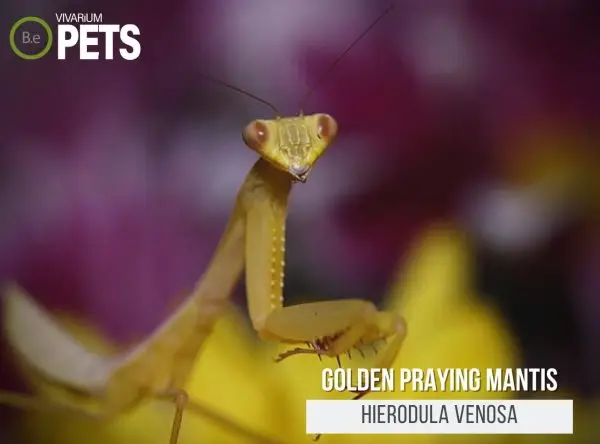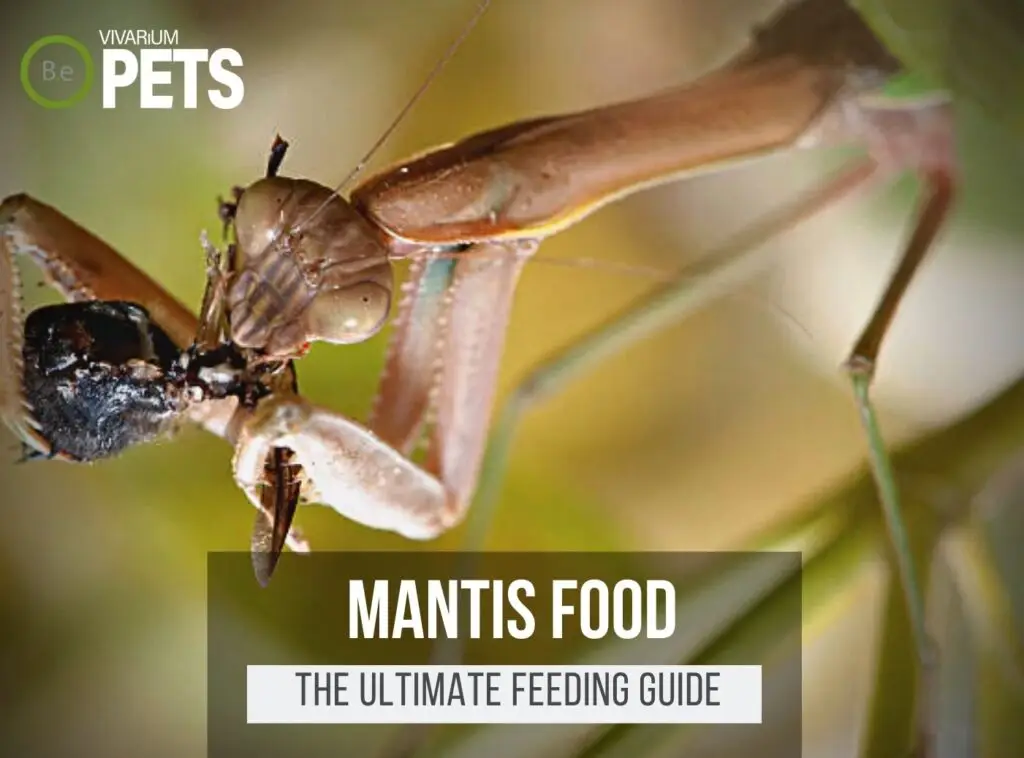The golden praying mantis is a colorful variant to have as a companion and adds a real lemon twist to the usually green predator.
Although small in size, this fascinating insect requires special care to ensure that it has a healthy, comfortable life.
In this Hierodula venosa care guide, you’ll learn what habitat and food this type of pet praying mantis needs.
We will also cover how to breed and raise a golden baby mantis, and potential health problems to look out for.
| Characteristics: | |
|---|---|
| Common Name | Golden Praying Mantis |
| Family Name | Mantidae |
| Scientific Name | Hierodula venosa |
| Use | Pets |
| Temperament | Non-aggressive |
| Lifespan | 6 to 12 Months |
| Diet | Insectivore |
| Adult Size | 3 to 4 in |
| Breeding Type | Egg Layer |
| Care Level | Moderate |
| Minimum Tank Size | 5 Gallon |
| pH | 6.0-7.0 |
| Hardness | Moderate |
| Temperature | 75-85°F |
Table Of Contents:
ToggleWhat Are Golden Praying Mantis?
The Golden Praying Mantis, also known by its scientific name Hierodula venosa, belongs to the family Mantidae.
These vibrant insects typically have bright yellow or gold bodies and are native to parts of Southeast Asia.
They are highly flexible and agile animals that can even turn their heads to take in the surrounding environment.
What Does Golden Praying Mantis Look Like?
Hierodula venosa is a medium-sized species of mantis, typically ranging from 3-4 inches in length.
Its color ranges from golden yellow to brown and features a distinct pattern of yellow stripes or dots along the legs.
The body shape is ovoid and the head is triangular, while the wings spread out like a fan when open.
They have two large eyes which are used for visualizing their prey.
Their upper pair of legs point outwards in a characteristic prayer-like pose from which the common name “praying mantis” originates.
Benefits Of Using Golden Praying Mantis
Golden praying mantis make great additions to many types of vivariums.
Not only do they provide a bit of entertainment as they climb and explore, but they also make for an interesting conversation piece.
Keeping Hierodula venosa can also help to keep pests out of your enclosure as mantids are known to eat smaller insects and arthropods, thereby naturally controlling the population of unwanted insects or bugs.
Furthermore, these little creatures are relatively low-maintenance and can live up to a year, making them ideal terrarium residents.

Golden Praying Mantis Facts
The golden praying mantis has a striking appearance, making it a popular choice among insect enthusiasts.
They have a voracious appetite in the wild for flying insects and spiders, primarily as an ambush predator.
Hierodula venosa has a relatively short lifespan of up to a year, with females usually living a few months less.
Breeding occurs seasonally and is naturally dependent on temperature, humidity, and prey availability.
Habitat
H. venosa is a species of praying mantis that originates from Southeast Asia.
Their natural habitat consists of warmer, jungle-like terrain, and many species prefer humid conditions.
Many are found in lowland areas on plants and trees, and some are even found in high-altitude areas.
The wild population is often threatened by deforestation, which can severely reduce their habitats.
Diet
In its natural habitat, Hierodula venosa feeds mostly on small insects including flies, aphids, crickets, and spiders.
It has also been known to feed on smaller mantises.
To ensure the health and well-being of the mantis, providing it with a varied diet of juvenile insects and fly larvae is ideal.
The type of insects it consumes depends largely on the size and age of the mantis.
Younger mantises tend to feed more on softer-bodied prey such as ants and aphids, while adult mantises may consume larger prey such as crickets and spiders.
Additionally, adult mantises may join larger animals such as lizards and birds in hunting for food.
In the wild, the golden praying mantis’s diet plays an important role in its survival capabilities and helps maintain the delicate balance of predators and prey in its environment.
Temperament
Golden praying mantes have been reported to be quite gentle, docile, and peaceful creatures around humans and other animals.
They also have been observed to exhibit qualities of shyness and calmness, rarely displaying signs of aggression or hostility.
When kept as a pet, this mantis may even follow the owner with their head going in the same direction and seem to show a form of curiosity towards its owner.
Hierodula venosa display an active hunting behavior, often perching on plants or stems and reaching out to catch their prey with their spiny forelegs.
This predatory behavior means they are uncomfortable with other animals and should not be kept around more aggressive, smaller, or flight-based animals such as birds, mammals, or reptiles.
However, they generally have no issues with being handled by humans, and even show signs of pleasure or enjoyment when appropriately cared for.
Lifespan
The lifespan of Hierodula venosa may vary depending on the environment and other conditions.
However, the average lifespan in the wild is about 6-8 months. In captivity, with proper care and nutrition, they may live up to one year.
The life cycle of the golden praying mantis includes multiple stages: egg, nymph, adult, and death.
After mating, females lay eggs that hatch in the last spring and summer, typically in May or June.
Young golden mantises emerge from the egg in the form of nymphs. Nymphs then will molt several times before they reach maturity.
During the maturity stages, they are able to reproduce and lay eggs that will eventually hatch into nymphs, completing the cycle.
Breeding
Mating and reproduction in Hierodula venosa is a complicated process!
Unlike other insect species that reproduce through simple parthenogenesis, golden praying mantises require a male and female to mate in order for reproduction to occur.
This is because there is a sexual dimorphism between males and females that is not present in; parthenogenetic species.
During mating, the larger female will grab onto the smaller male and they will remain attached until the female is ready to lay her eggs.
The male will then leave once she has laid her eggs.
These eggs are typically deposited in a warm, moist area and then protected by the female until they hatch.
Each egg sac can contain hundreds of eggs.
Once the eggs hatch, the nymphs will look for food and will shed their skins multiple times until they reach the adult stage.
In the wild, most golden praying mantises will live to adulthood, but captivity raises their chance of survival by providing a safe, plentiful source of food and love.
Where To Find Golden Praying Mantis
Hierodula venosa makes an excellent pet insect for beginners.
You may be able to find them in the wild, but generally, they are typically sold as adults at pet stores and online shops.
If you’re looking to buy a golden praying mantis in the wild, it’s best to look for them in the late spring and through the summer.
A good place to find them is in the branches of trees and long grasses.
It would help if you also looked for them in gardens, fields, meadows, and shrubberies.
When buying a praying mantis from a shop, you can be sure that it is of healthy stock and will include information about the species and its behavior.
Golden Praying Mantis Care
To provide the best possible care for a Golden Praying Mantis, it is important to provide a suitable habitat with appropriate food sources, breed and raise the baby mantis correctly, handle the mantis gently, and watch for potential health problems.
Tank Requirements
When creating a habitat for Hierodula venosa, aim for a tank that is at least 5-10 gallons.
Glass terrariums, plastic insect cages, or custom-built enclosures all work well.
The ideal temperature range is between 75-85 °F.
Humidity should remain consistent around 50-70%.
It is recommended to use a terrarium substrate like peat moss, and coco fiber, which can be lightly misted if necessary.
Terrarium lighting should be indirect, from a fluorescent or LED light, and should be kept on for 14-17 hours a day.
The pH level of water offered should stay around 6-7 and the hardness should be kept between 3-4.
Ensure that the tank has plenty of airflow to help regulate the temperature.
What Does A Golden Praying Mantis Eat?
Feeding any pet is an essential part of its care.
When it comes to Hierodula venosa, diet is especially vital as it can affect their overall health and well-being.
When looking for food for your mantis, you’ll want to focus on live insects.
The most common food sources include small house flies, moths, grasshoppers, crickets, and waxworms.
It’s important to note that the insects should be no more than twice the size of your mantis in order for them to be able to feed properly.
As with any pet, it’s good practice to ensure that you are feeding your mantis a balanced diet.
For instance, you should consider supplementing their diet with vitamins or calcium.
Additionally, a small bowl of water should be available for them to drink.
Overall, when it comes to feeding your golden praying mantis, you want to make sure that they have plenty of live insects to feed on and also consider providing essential vitamins and minerals to supplement their diet.
If you’re looking for a more detailed approach to feeding these critters, be sure to check out my ultimate DIY Praying Mantis food guide. I give a more in-depth explanation of the best foods and my favorite recipe.
Best Tankmates For Golden Praying Mantis
If you’re considering keeping Hierodula venosa as a pet, the best tankmates to choose from are invertebrates, such as isopods, springtails, and millipedes.
The Golden Praying Mantis can coexist peacefully with fast-moving and low-maintenance crustaceans in the same terrarium.
Other animals that have similar beneficial qualities to the Golden Praying Mantis include roaches, which can be an ideal food source for a mantis, and other species of mantis.
Keeping a different mantis species in the same tank as the Golden Praying Mantis can be risky, however, as different species may fight each other or attempt to mate.
Conclusion
Hierodula venosa is a fascinating insect that requires special care to thrive and be healthy.
This care guide provided you with information on what habitat and food it needs, how to breed and raise baby mantis, and potential health problems.
When cared for properly, with patience and dedication, owning a golden praying mantis can be a rewarding journey.
Frequently Asked Questions
The average size of the golden mantis is anywhere between 3 – 4 inches in length.
The golden color praying mantis (Hierodula venosa) is a species of large mantis native to south–east Asian countries, like Indonesia and Thailand. It has a unique golden–brown color and can grow to an impressive size of up to 4 inches. It is an insectivorous species, meaning it feeds mainly on other insects.

